Complete Buyers Guide
THE COMPLETE HOT TUB BUYER’S GUIDE

Are you considering adding a hot tub to your home environment? You’ve arrived at the right place! We’ve put together a guide that answers the most common questions about why and how to purchase a hot tub. First, we’ll discuss the reasons to consider hot tub ownership, so you can decide if it’s worth the investment. Then, we’ll walk you through the steps involved in buying a hot tub, from which model to choose to long term maintenance and water care.
REASONS TO BUY A HOT TUB
Health & Wellness
Achieving optimal health and wellness requires much more than just healthy eating. High-pressure work environments, long commutes, children’s extracurricular activities can all take a toll on your health if not addressed. Today, many people turn to hydrotherapy to reduce stress, improve circulation, and to alleviate joint pain.
Hydrotherapy massage is administered in three parts: heat, buoyancy and jets. Soaking in warm water expands circulatory organs and reduces muscle tension. Buoyancy reduces your body weight by 90% which literally takes the weight off your stressed body parts[1]. Massaging jets reduce physical tension and mental stress. These elements of heat, buoyancy, and hydrotherapy massage, all working together, provide numerous benefits to your long-term health and wellness.
Relaxation & Leisure
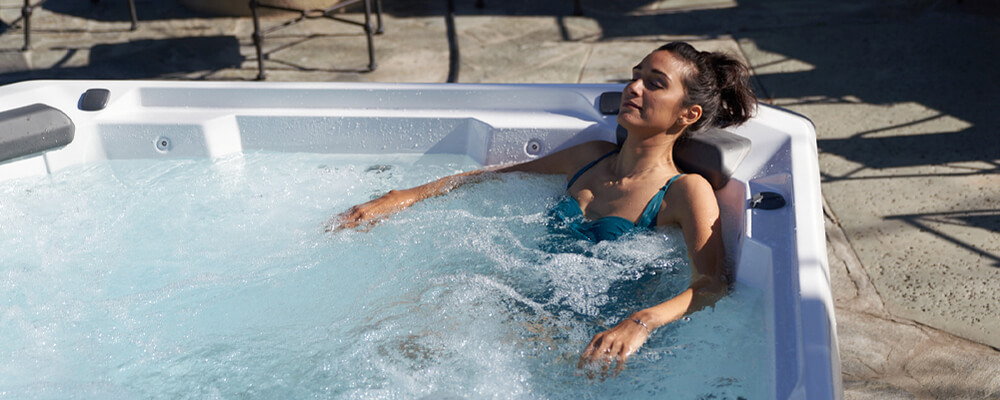
A common reason you might consider buying a hot tub is to simply relax. Hot tubs provide some of the most relaxation available and allow you to enjoy some much needed “you time”. A 20-minute soak in a hot tub can help reinvigorate your body and clear your mind[2]. This can allow for your day ahead to be more fulfilling. Hot tub soaking also allows your body to let go and helps you to sleep better at night. Complete relaxation can be achieved by closing your eyes and taking occasional deep breaths.
Family Time
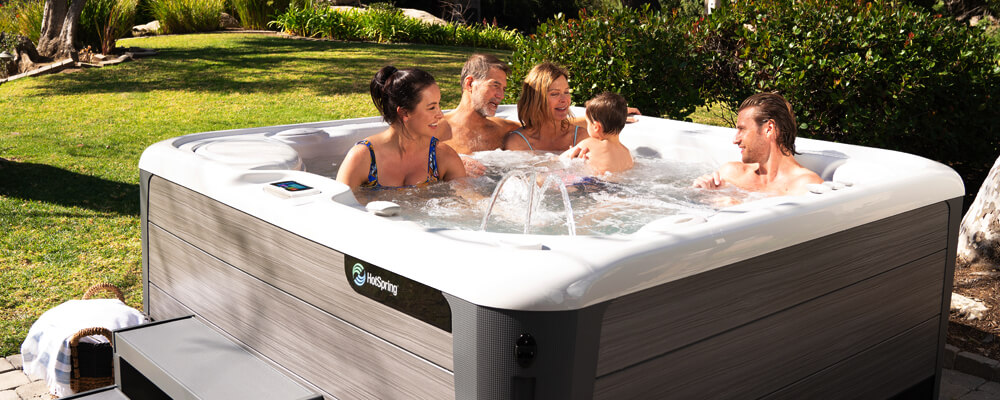
Hot tubs are an excellent means of getting some face time (of the non-app variety) with your children and your partner. In today’s constantly “connected” world, hot tubbing provides your family with a much-needed break from smartphones and other electronic devices. Soaking in the hot tub brings you all together in a way you haven’t been able to in quite some time. The conversations you will have, when there are no device screens to distract you all, are some of the most rewarding reasons people love their hot tubs. With a hot tub, you can spend more time together.
Entertaining Guests
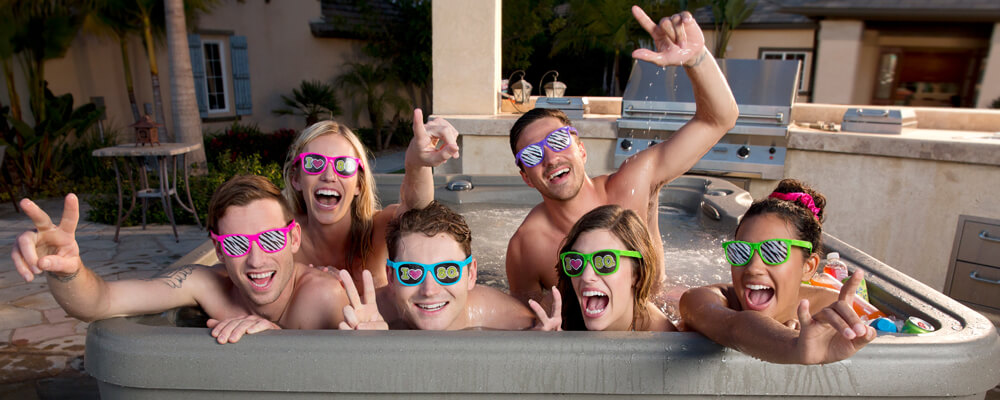
Another great reason to purchase a hot tub is for entertaining guests. Hot tubs are perfect for social events (i.e. barbecues, birthday parties, etc.) and will add unforgettable fun for your guests to be entertained and happy. Effortlessly host backyard parties by letting your guests relax and enjoy the warmth and benefits of your hot tub. Many hot tubs also have waterfall features and audio systems that can add to your backyard ambiance.
HOW TO BUY A HOT TUB
When you’re in the process of purchasing a hot tub, there are important measures you should consider – Deciding where you want your hot tub placed, properly preparing that space, and more. Below are several steps we recommend taking before making a final decision.
Placement
Installation Prep
When determining how your hot tub will be installed, you may want to schedule an in-home consultation or video call with the local dealer that will be providing your hot tub. The sales representative can help answer questions about placement and installation access.
For the most simple installations, you can easily purchase a hot tub with a plug and play connection that fits a standard 120 volt outlet.
Electrical work for a hot tub must be done by a licensed electrician. Regardless of whether your hot tub will be permanently installed or not, it is best to consult with your local dealer and a licensed electrical contractor to set up and perform the installation needed for the spa you choose.
Do you live in Northern California? Schedule an In-home Consultation with us.

Indoors/Outdoors
When purchasing a hot tub, you’ll also want to consider if you’ll be placing the hot tub outdoors or indoors. If you’re placing your hot tub outdoors, make sure the build quality of your hot tub spa can hold up to the local climate. While acrylic is the most common spa shell material, other options include roto mold polymer, vinyl and wood. Whether you put your outdoor spa on a porch, patio, or deck, you will want to prepare the site prior to the delivery of your hot tub. Before deciding on the size of your hot tub, be sure to measure the area your hot tub will be placed in.
If you plan to have your hot tub indoors, make sure doorways and hallways are large enough for the hot tub to pass through usually being delivered on it’s side. Again, the size of your hot tub and desired location play a big role in whether or not the hot tub will fit properly. Determine the size of your space and decide if your prospective hot tub is of an appropriate size. Additionally, it is important that your indoor location is leveled and can support the weight of the hot tub. If you are considering an acrylic shell hot tub, be sure that your space can hold 150 lbs per sq. ft of pressure.
For outside and inside areas, it is recommended to account for space for a cover lifter device behind the hot tub as well as space for entry steps at the front of the hot tub. These require more space than the footprint of the spa itself and make the user experience more enjoyable. Electrical connections for each hot tub differ, so you will want to decide on a specific model before you have electrical installation done.
Hot Tub Surface
When installing your hot tub, it is recommended to have it placed on either a poured concrete patio, a spa pad, or a solid deck. You’ll want to ensure that the site your hot tub will be installed on is leveled, flat, and solid so that it can support the weight and pressure of the hot tub when filled with water.
If you are placing your hot tub on a deck, make sure your deck is reinforced and sturdy enough to support the filled hot tub. To determine if your deck is sturdy enough, consult with a licensed contractor or engineer, with hot tub experience if possible, to have your deck inspected. Additionally, you may want to consider creating a walkway to your hot tub if you’re placing it outdoors. A walkway can help you avoid walking on dirt, grass, and other debris before setting foot in your hot tub. Having a clean entry point will help you to keep your hot tub water clean with less maintenance required.
What you should avoid using as a surface for your hot tub are paving stones, bricks, or other surfaces that can sink or adjust with the soil base they are sitting on. Paving stones can be uneven or adjust over time and ultimately cause wear and tear on your hot tub’s frame.
The surface you place the hot tub on does not have to be perfectly level so long as it is a single plane. In other words, your concrete patio could drain a quarter inch per foot away from the house and as long as the drainage is in one direction and the concrete surface is flat, the hot tub will be okay on that substrate. Just know that if your surface is not level, the water line in your hot tub will be level and look uneven compared to the top of the spa. As long as the surface is a single plane and does not have dips or bumps or multiple drainage planes, the surface will likely be okay. It is not recommended to shim most hot tubs. Water is very heavy and shimming could cause tweaking to your hot tub frame.
Easy Access?
Another key factor you’ll want to consider is if your desired site is easily accessible for your installers. It is important that you properly survey your designated site to determine if the installers can deliver and install your hot tub without hassle. This step can also tie into the installation preparation step. If you are installing indoors, you’ll want to make sure your walkways are clear of objects such as desks and other furniture and that the room is easy to access. If outdoors, which is most common for hot tubs, ensure the area is clear of possible outdoor furniture, lawn equipment, etc. to ensure a smooth installation.
Preparing and clearing your site for installers to easily access also prevents possible damage to your belongings or to the hot tub itself. You will want to make sure walkways have sufficient clearance from AC units, gas meters, wall lights, or low eaves or gutters. It is also important to consider steep inclines, stairs, or tight corners that the spa may need to travel along to get to its final destination. Hot Tubs Are usually delivered by being put up on their side on a cart. This means that the access pathway to your final destination needs to be wider than the height of the spa and taller than the longest side of the spa plus about 6 inches for the height of the cart.
Nearby Water Source
It is important to determine if the site you will place your hot tub in has a nearby water source. Most modern hot tubs do not need to be connected to a water source, but having a nearby spigot to connect a hose to for filling the spa, makes the user experience nicest. Additionally, you should make enough room for drainage. It is usually recommended to drain and refill a normal hot tub every 3 to 4 months or as needed depending on the use a hot tub gets. Salt water system hot tubs can often times have the water last 6 or more months before needing to drain and refill.
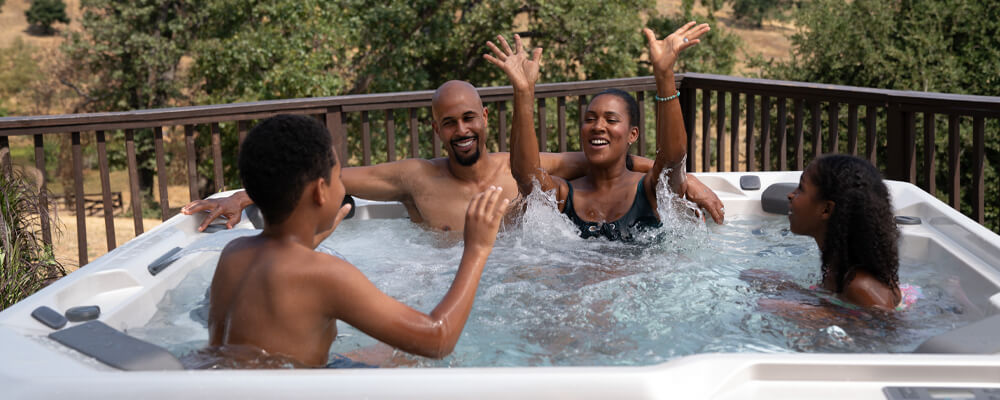
Budget
Determine Your Budget
Before researching specific hot tub models, consider what your budget will be both for the initial cost of the hot tub as well as ongoing expenses, such as water care products, replacement filters, etc. We go into more depth about the total cost of ownership in the next section. As far as the initial cost of buying a hot tub, typically most models fall into one of three price categories:
– Entry level: $4,500 – $8,499
– Mid-range: $8,500 – $13,999
– High-end: $14,000 – $24,999+
Hot tubs that fall under the Entry-level tier are either:
Plug-n-play 115v spas with rotomold or acrylic shells
Off-brand hot tubs (often sold through big box or internet stores) meant to undercut name brand spas (later in this guide we will go into reasons why you should avoid off-brand hot tubs)
If you’re shopping on a tight budget, plug-n-play hot tubs are an excellent choice that even offer some advantages over Mid-range and High-end spas. Most plug-n-play models have a dry weight of 300-400 lbs, making them much easier to move. They can fit on small patios, and don’t usually require special electrical work – just plug and play!
Deciding between a High-end or Mid-range hot tub is a bit more challenging. Much like buying a car, you need to decide what features are must haves and what features you can live without. For some buyers the most important factor is ease of water care, for others it’s the number and type of massage jets, and sometimes the deciding factor is what color the hot tub comes in!
It is important to work with your local dealer to discuss the features of the different types of hot tub models. If they are pushing you into buying a specific type of spa that doesn’t appeal to you, you might want to find another dealer to talk to who will allow you to choose the model you find fits your needs best. Do not work with a seller who is pressuring you into buying what they want to sell. Work with a seller who listens to your wants and needs and wants to help you to get the right hot tub for you.
Often, the more you spend to purchase a hot tub, the higher quality its components are, and the less it will cost over time for you to own it. Read on to understand better the cost of ownership and why you might want to buy a more expensive hot tub.
Total Cost of Ownership
You’re probably already familiar with the term Total Cost of Ownership, but you may not know all the contributing factors when it comes to hot tubs. By far the largest cost is the hot tub itself. Additional costs include:
Up-front costs:
– Hot tub cover upgrade
– Platform or spa pad
– Electrician
Ongoing costs:
– Electricity
– Water
– Chemicals
– Spa accessories
– Replacement filters
– Maintenance and Repairs
You’ll want to remember that the operation costs, hot tub accessories, and any chemicals used are all factors included in the total cost of ownership. Expenses for your hot tub do not stop at the initial purchase of the hot tub. In fact, site preparation, electricity bills, and repair expenses are also included in your total cost. Other possible factors in the total lifetime cost of your hot tub can include: poor insulation, thin spa covers, cheap equipment, and poor workmanship.
Determine How You Will Pay
You will need to determine if you’ll be paying in full at the time of purchase or if you will finance your hot tub. If you intend on financing your hot tub, you should consider discussing the matter first with the hot tub retailer. The retailer may offer you the ability to finance your hot tub via a Home Improvement or Outdoor credit card or through a bank that offers special payment plans.
You can also consider financing through your personal credit card or a home equity loan. However, you should consider your line of credit and how hefty the expense of your hot tub is. Think about the initial and additional costs of your hot tub before opting to use your credit card or a loan. It is also important that you are comfortable with the price range of your desired hot tub and that it aligns with your budget. Nevertheless, if the hot tub you are considering does not fit your budget, you can check to see if there are any promotions or offers on the hot tub or search for a similar hot tub that is more in-tune with your budget.
Interested in Financing?
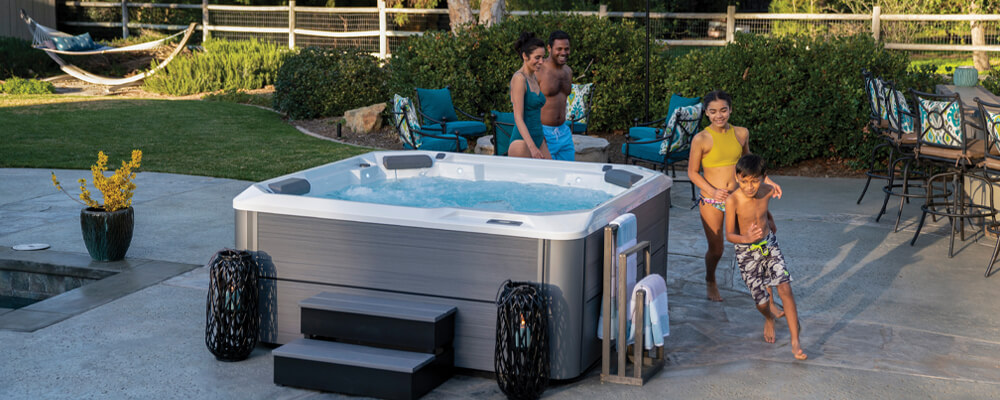
Research Hot Tub Brands
Quality vs. Price
As aforementioned, purchasing a hot tub based on how affordable the initial price is may not be a good thing to do. Saving money up front could cost you in repairs and additional electrical costs in the long-run, thus resulting in you spending unnecessary money. Researching and purchasing a hot tub built with quality can actually help you save on costs in the long run and prove to be more efficient. Conduct research on quality hot tub brands before you impulsively buy a hot tub that’s “on sale” or available for a low price.
Reliability & Safety
One of the main factors to consider when deciding where to buy your hot tub is the reputation and reliability of the manufacturer and their hot tubs. When researching for quality manufacturers, check how reputable the manufacturer is by analyzing reviews and checking for recommendations and references.
The hot tub models you look into should be well-built, durable, and made with quality materials. As stated by Watkins Wellness, the manufacturer of Hot Spring and Caldera spas, “Buying a hot tub that will last over time is an important consideration for potential spa owners.” Do not purchase hot tubs directly from online sellers and hot tub exhibitors at fairs, carnivals, and parking lots as they are often not very credible and look to upcharge customers. Reputable businesses like The Hot Tub Store have local showrooms and services, whereas these types of hot tub exhibitors do not. Also note that when you’re searching for a proper hot tub model, it should be tested independently by a testing agency such as UL or ETL.
Build Materials and Engineered Proprietary Parts
Another factor you’ll want to consider is the materials used to manufacture the hot tub. There are many types of materials a hot tub can be made out of. Two of the most common materials include acrylic shell and roto-molded. The difference between a roto-molded hot tub and an acrylic shell hot tub is generally the price and the craftsmanship. Acrylic material is very durable, versatile, and elegant. Acrylic can be easily molded into complex shapes and customized for enhanced comfort and personalized seating. Supported by a frame structure complete with wooden or synthetic-type cabinets, acrylic shell spas can often be quite costly, and that is where roto-molded spas differ.
Roto-molded spas are built with the shell and cabinets conjoined. This allows the spa to have durability and a maintenance-free structure. Roto-molded hot tubs can also come with many of the same features as an acrylic shell spa, but may include a simpler design and lower quality components. Not all roto-molded spas are built the same and some manufacturers may utilize less expensive features to offer the product at a lower purchase price. Thus, it is important to consider the features that are important for your hot tub to have, as well as the quality.
There are many hot tub companies that have come and gone over the years. Often spas are built using off the shelf parts not specifically engineered for the size and number of jets in that model. This can cause a spa to be less energy efficient and can be problematic later if certain parts are needed and are no longer available. Selecting a brand that has been around for a long time and that continues to provide specially designed parts for the hot tubs they made many years ago is a very important factor you should consider when purchasing your new spa. Manufacturers like Watkins Wellness, the maker of Hot Spring spas, engineers specialty parts for each model they build and they promise to have parts available to their dealers for 20 years. This promise is a stress reliever worth consideration when investing in a new spa.
Water Care Systems: Filtration, Circulation Pumps, Ozone, Salt, @Ease, Other
Other factors to consider when choosing a hot tub include the amount of available filtration area. Some spas come with one filter while others come with two or even up to five. Generally speaking, the more filters, the higher the quality of the filtration and the easier it will be to keep your hot tub water clean and enjoyable.
Hot tubs need to circulate the water through the filters and the heater. Entry level and mid range hot tubs normally use the jet pump to circulate the water. This means that the spa kicks on with the jet pump on low speed anytime the hot tub needs to heat to your set temperature. Only when the jet pumps are running is the spa water moving through the filter system. Higher quality hot tubs offer quiet energy efficient circulation pumps that circulate the water through the filters and across the heater 24 hours a day. These quiet circulation pumps use less energy than the larger jet pump and keep the water clean and hot and always ready to use. Quiet circulation might be especially important if you will be putting your new hot tub near a bedroom or close to your neighbor as the jet pump won’t kick on during the night with this kind of specialty circulation pump option.
Another factor to consider is if the hot tub you are researching comes with ozone technologies. Ozone technology, simply referred to as ozonators, care for the spa water and either use ultraviolet light to eliminate bacteria or Corona discharge, which is an electrical discharge that occurs through the ionization of a fluid (i.e. the spa water). Ozonators can be found inside the front panel of the hot tub and are generally in most higher quality hot tubs. It is recommended to get a hot tub with ozonators or to install ozonators in your hot tub (if there aren’t any) because they help keep the water clean. Note, however, that ozonators do not act as a replacement for the use of chemicals.
The highest quality hot tubs are designed to work with a salt water sanitizing system. These systems require a small amount of salt to be added to the water and with some cool technology built into the equipment and the hot tub controls, the system naturally converts the salt into chlorine that cleans the water. These systems are the most natural water care systems and are available only on the more expensive and higher quality hot tubs. For the nicest soft smooth hot tub water experience, you will want to consider investing in a hot tub with a salt system.
A great option available on many mid range hot tubs is the @ease cartridge system. This system is designed to use simple replacement cartridges that inject chemicals and minerals into the water as needed to keep the water safe and easier to use. If the hot tub you choose does not have the cartridge system available, you might also consider using a @ease floater system available for sale from your local hot tub dealer.
Whatever hot tub you choose, you will need to use water balancing products and sanitizer products along with one of the systems mentioned above. Your hot tub dealer should be able to provide the products you will need along with the guidance necessary to enjoy your hot tub.
Plumbing
Consider the plumbing aspects of the hot tub you are researching. Check to see what filter system the hot tub uses. Is it a suction or pressure type? Most modern-day spas use the suction filter system which is always top mounted for easy cartridge access. However, there are still spas available that use pressure type filter systems which are housed in a sealed canister, rather than incorporated with a surface skimmer. Determine also the pump and heater system of the spa. Spa pumps provide water flow to the jets. It is important to note that you should not be drawn to buy a hot tub with several pumps (as this can decrease the efficiency of your hot tub and result in energy costs). Instead, your hot tub should have a balanced amount of jets to pumps appropriately sized for the number of jets in the spa model.
Other aspects of plumbing to analyze include the air induction, air blower, drain, and any spa lights the hot tub you are considering may have. Most spas come with a drain bib or “plastic faucet” which can be found in the accessible panel. However, there are some spas that have to be siphoned and do not include a drain, which you will have to be aware of. Overall, in terms of plumbing and the proper wiring of a hot tub, it is always best to consult a professional contractor and/or electrician.
Checklist of Desired Features/Specs
To better select a hot tub that fits your needs, you should create a feature checklist to ensure the hot tub you are considering aligns with the hot tub you envision. Key features or specifications you should include on your list are:
– Size and Number of Seats
– Energy Efficiency
– Gentle Soothing Jets or Strong Hydrotherapy Jets
– Seating with Lounge or No Lounge
– Electrical Voltage
Size
In terms of size, you should think about how many people will be using your hot tub. How many members are in your family? Are you planning to use your hot tub to entertain guests? These are questions you should consider when deciding on the size of your hot tub. Hot tubs typically come in 3, 5, 6, and 7+ person sizes. Nevertheless, before impulsively buying a hot tub based on its looks or cost, you should consider the space of the site you will place your hot tub in. The size of your site plays a large role in what size hot tub you should get.
Efficiency
Everyone wants a hot tub that is efficient. Some manufacturers offer efficiency calculators so that you can get an idea of how much your monthly electrical costs will be. Other ways that you can judge efficiency is by comparing build materials, plumbing. Some manufacturers also include heat efficient technologies into the design of the spa. Reading up on product brochures or talking with local dealer representatives will help you find these technologies.
As for efficient technologies, search for models that include well-made, efficient jets and pumps to reduce the amount of energy that is used and help you save on electrical or energy costs. Also consider brands that construct their hot tubs with full foam insulation, which allows the hot tub to retain heat better and helps you further save on energy costs.
All new hot tubs should come with a basic thermal cover. When deciding on a hot tub, beware of any dealers that try to pass off the thermal cover as a bonus item, as they are meant to be included.
Jets
As for jets, research brands that use well-engineered jets that provide great performance without using too much energy. Your hot tub’s jets should emit enough power to give you an invigorating hydromassage without running up your energy bill. Make sure that the hot tub has a balanced amount of jets that are made with quality materials and designed to be efficient and durable. More jets in a hot tub is not necessarily a good thing. More jets usually means that either there are more jet pumps meaning more electricity use or the pressure is reduced when spreading power over more jets. A well designed hot tub will actually have less jets, but will have them placed appropriately to provide a really nice massage experience with energy efficient jet pump design. Each seat tends to have a different massage experience and it is recommended that you move from one seat to another to get the full spectrum of jetting.
Some hot tubs have more vigorous hydrotherapy jets while others have less power available and are more designed for gentle soothing jetting and quiet soaking. You will want to decide which of these is more important to you so your sales person can help guide you to the best hot tub model for your needs.
Lounge/No Lounge
When researching hot tubs, you should consider if you want the hot tub to have lounge seats or not. Lounge seats, or “reclining seats” provide a comfortable laid back experience. They are also perfect for individuals purchasing a hot tub for health and relaxation benefits. The seats are molded in a laid-back position and typically include a series of jets for more relaxation. When deciding if you want a lounge seat or not, you should think back to how much space you want your hot tub to have and how many guests you’d like to fit in your hot tub at a time. Lounge seats can take up room in your hot tub and result in less seating. Therefore, if you plan to entertain guests frequently or have a large family, you may want to opt for a hot tub with no lounge seat. Nevertheless, there are also models available that offer semi-reclined seats in an effort to increase the amount of space available while still providing the “lounge experience.”
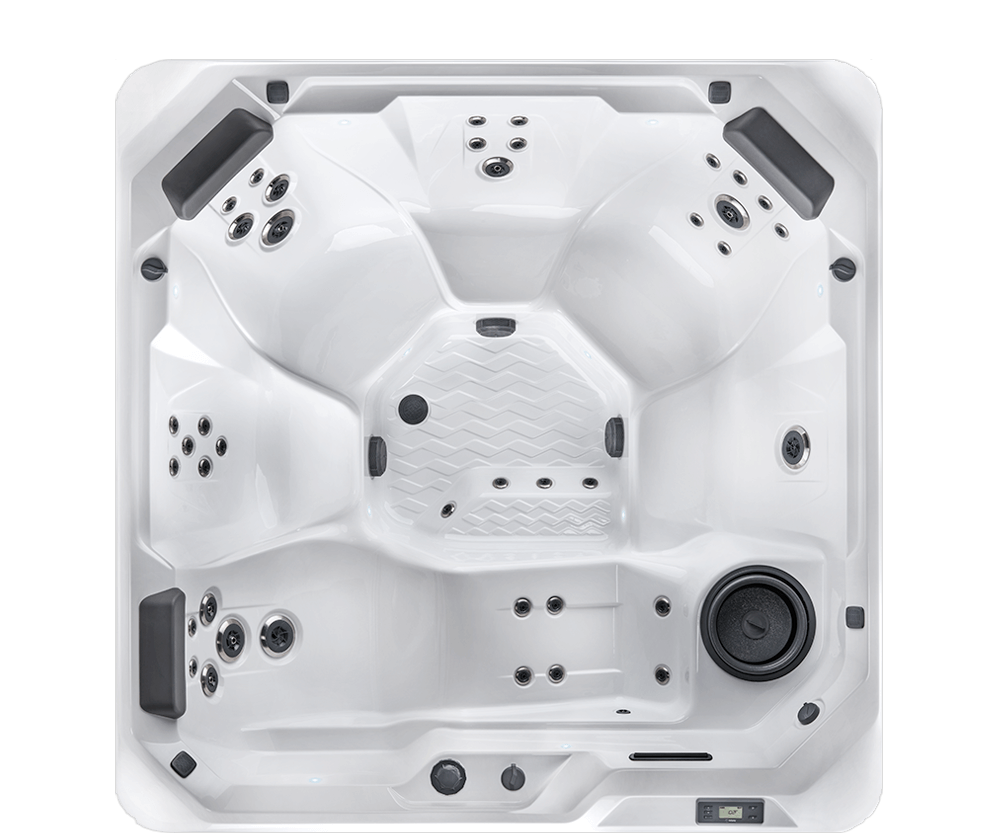
Lounge Seating
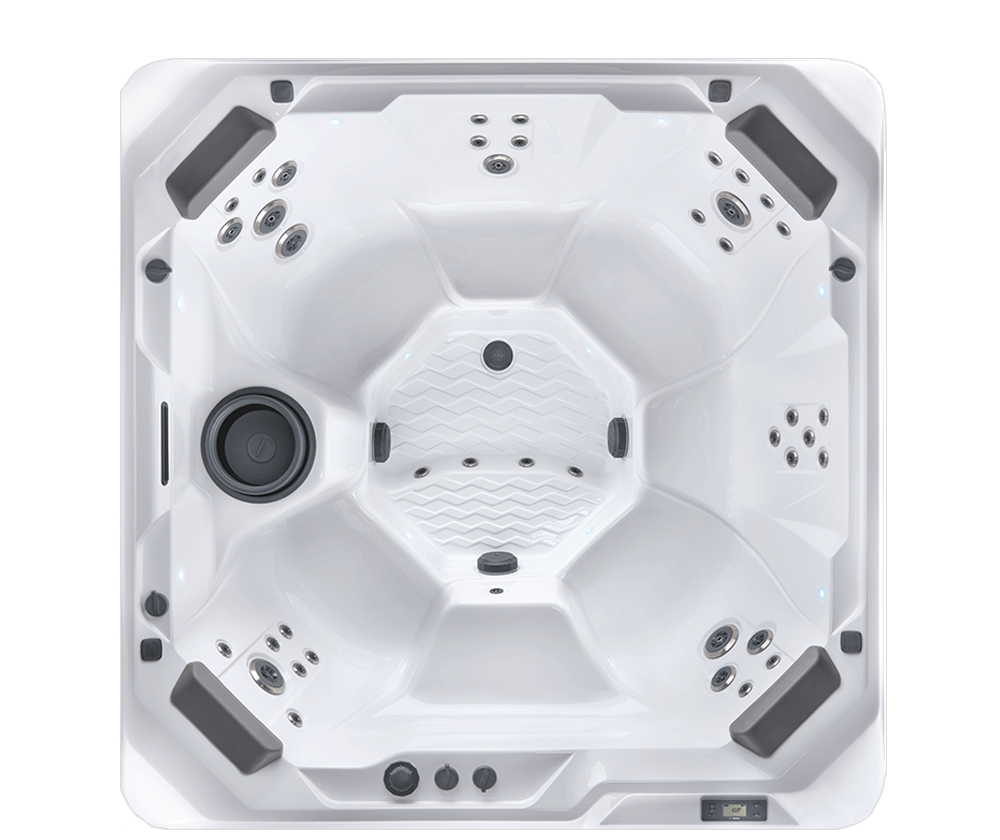
Open Seating
Voltage
When looking at the voltage of hot tub models, you should consider if you want your hot tub to have a voltage of 120V or 240V. What’s the difference? The heating time of the hot tub, the jets, and the convenience. A 240V hot tub will heat up faster than a 120V hot tub and may have more power to support more jets. Nevertheless, there are individuals who opt for a 120V hot tub for portability and convenience. This is because 120V hot tubs do not require additional wiring. Note that most roto-molded hot tubs use 120V while many larger acrylic hot tubs use 240V. Each model is designed to operate on the voltage it comes in standard from the factory. Most 120V hot tubs can be converted to 240V if desired, but this is not usually necessary to do. 240V hot tubs can not be converted to run on 120V.
Manufacturer Incentives/Rebates
When you research hot tub brands, it is beneficial to look for any deals or incentives from that manufacturer that you can bring with you on your way to a hot tub showroom. Incentives, promotions, or rebates can help you save money upon or after your hot tub purchase and can ultimately bring the hot tub closer to your budget. Don’t hesitate to call the hot tub retailer before your visit to ask if there are any current promotions or offers.
Manufacturer Warranty
It is important to find and read through a hot tub manufacturer’s warranty before deciding on their hot tub. You should check to see if there is a pro-rate or if on-site service is provided, among many things. You should also discover if the hot tub services will be taken care of by the dealer itself or a third party. Does the warranty cover repairs or damages to the hot tub? Does the warranty only cover parts? How long is the warranty for? These are questions you should ask while reading through a manufacturer’s warranty.
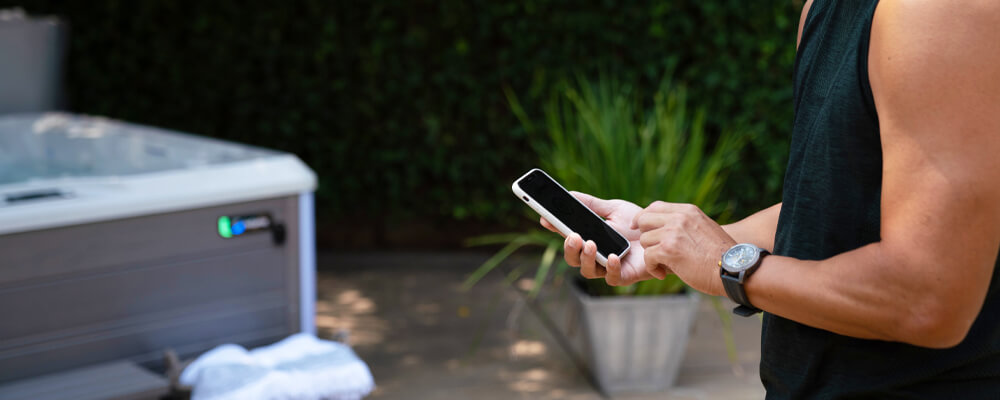
Research Local Dealers
Types of Sellers
There are primarily two types of sellers in the hot tub industry: reputable and non-reputable sellers. Hot tub exhibitors at fairs, carnivals, or parking lot sales generally aren’t reputable and often look to engage potential buyers into high-pressure situations. Non-reputable sellers do not have local showrooms. As a general rule, big purchases should not be impulse buys. Splurging on a trip to the grocery store won’t have a big impact on your bottom line, but allowing yourself to be pressured into buying an off-brand hot tub from a seller that won’t be around to service it can be a costly mistake. The mark-down doesn’t matter if it’s not a brand or dealer that you can trust. Hot tubs are meant to improve your quality of life, but purchasing from a non-reputable seller can have the opposite effect.
We recommend that you research local dealerships that have showrooms and offer wet tests, allowing you to try out the hot tub beforehand. Look at reviews of dealers online to get an idea of what it’s like working with them. Quality dealers have high referral rates and great online reviews. When trying to determine dealer credibility, you should ask for references from hot tub buyers in your neighborhood in addition to online research. Check the online reviews for your local dealers to see what their customers are saying about them.
Years in Business
When researching local hot tub dealers, consider how long they’ve been in business and how long they have been selling the hot tub brands in their showrooms. This will give you an idea of how much expertise they have in selling, installing, and servicing a particular brand. You’ll want to work with a business that is knowledgeable and highly-praised in the hot tub industry and has spent many years selling quality hot tubs to customers. The Hot Tub Store, for example, is the oldest hot tub company in Northern California and has been selling and servicing the Hot Spring brand of hot tubs for more than 40 years.
In-House Service Staff
A hot tub dealer with an in-house service staff is more dependable and should be greatly considered, with one of the primary benefits being communication. It’s a lot easier for things to fall between the cracks when separate companies have to coordinate with one another. Having an in-house team also means the service professionals are well versed with the particular brands sold by the dealer. That means faster repairs, lower service bills and less hassle for you. The dealer should have factory certified technicians who can efficiently diagnose and repair your hot tub if it needs service. Note that most reputable dealers will charge a travel fee for their technician to arrive at your site. This is standard practice for appliance service providers. The Hot Tub Store has a staff of friendly schedulers who dispatch factory certified in-house technicians to assist customers with their service needs.
Parts On-Hand
If you or your significant other is a Do-It-Yourselfer, consider whether or not the dealers you are researching carry spare hot tub parts. Some, but not all, offer replacement pumps, jets, filters, plumbing parts, handrails, etc. If you prefer to tackle the project on your own, it’s nice to have a local dealer to purchase spa parts from, instead of waiting for an online delivery. The Hot Tub Store sells factory certified parts for all the hot tubs they represent.
Current Specials
Not all deals on hot tubs are bad. If you’ve determined that a hot tub seller is reputable, purchasing during a sale is a smart decision. Many sales events put on by dealers are at least partially backed by the manufacturer of the hot tub. Both the manufacturer and dealer will work together to lower the price in an effort to increase sales for a short period. The dealer’s goal is to sell enough hot tubs to offset the lower margins being made on each spa. This is a win for you, the buyer, and it can be a win for the dealer if they meet their quota.
When researching dealers, it’s always a good idea to check their website for any upcoming sales events or specials. If you can’t find anything on their website, you can also give them a call and ask directly.
Modern Website
A reputable dealer will have a well-constructed website that lets you know about their history and the brands they carry. They will make it easy to contact them, and will respond quickly to your messages. Good dealers will go as far as adding product pages that provide pictures, and information about features and specifications of each hot tub model that they sell. This makes it easy for you to learn about various brands/models before visiting the showroom or purchasing over the phone.
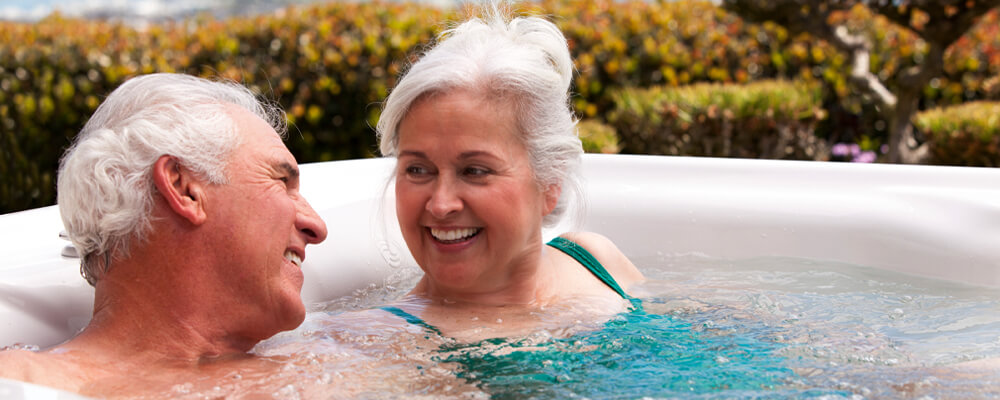
Visit Showrooms
Visually Inspect Showroom Models
When you go to a showroom to select your desired hot tub model, make sure to thoroughly inspect the models on display in the showroom. Don’t be afraid to ask the retailer questions about the available models. You should ask what type of brands the hot tubs on display are, what material they are made out of, and what features each model offers. Take note of the size dimensions of each hot tub on display and ensure that when you select the model of your choice, that it will precisely match the model displayed in the showroom.
Dry Test and Wet Test
Wet testing is the act of trying out a filled hot tub by soaking in it and testing its features. Most people choose to wet test with their arm to feel the power of certain jets. It is important to test a model that has similar features to the one you are considering. If you do want to wet test showroom models, many dealers will schedule a wet test appointment for before or after regular store hours. It is best to bring a thoroughly rinsed bathing suit and a towel for you to use. You might also want to bring a robe and flip flops to wear between the changing area and the hot tub.
Not everyone wants to or needs to actually get into a wet spa to make up their mind. In fact, more and more people are actually choosing a model without even going to a showroom. If you do visit a showroom, it is highly recommended to at least roll up your sleeves and feel some of the jets in a filled spa. This way you have a better idea of what kind of jetting you will be getting in the hot tub you are choosing.
You will likely find that only a few hot tubs have water in them. This is usually by design and a good reputable dealer will have certain models filled that allow you to experience similar jetting and seating available on other models in that spa’s collection of models. When visiting the showroom, it is good to get into the dry hot tub models to experience the different seating configurations. This is dry testing and doesn’t require you to get into a bathing suit. Feel the jets by dipping your arm into the filled models.
Sleep On It
After reviewing all of your options, you should go back home and sleep on it. Do not impulsively buy a hot tub the same day or feel pressured by the retailer to purchase a hot tub in that instant. You will need time to evaluate all of the hot tubs you reviewed and ask yourself questions to make an informed decision. Think about:
– The hot tub dealer’s experience (i.e. how long they’ve been selling)
– The quality of the brands and how long the dealer has carried them
– Features such as technologies, jets, and sanitation systems of each hot tub model
– Delivery services
– Payment options and warranty
– Hot tub add-ons (i.e. cover, steps) and accessories if applicable
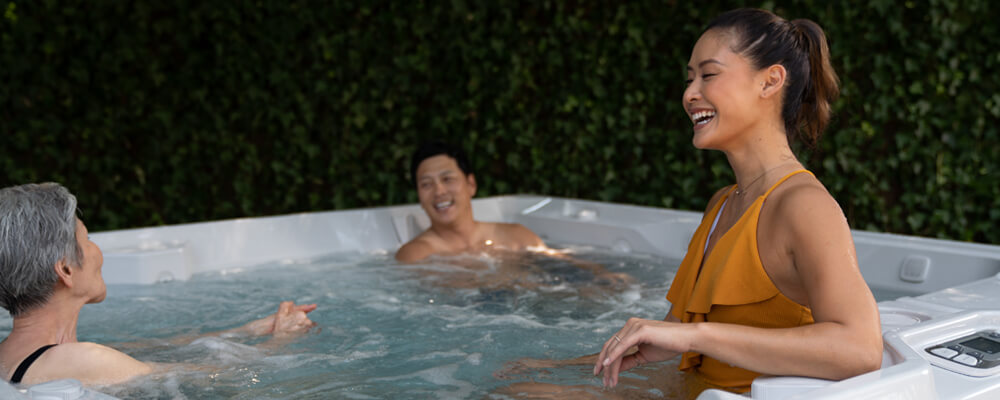
Purchase Hot Tub
Relationship with Sales Rep
When you’re in the process of buying a hot tub, you should make sure you can talk freely and comfortably with your sales representative. Buying a hot tub should be a great experience and should not be stressful. Consider how well the sales representative communicates with you. Do they pressure or rush you? Are they inconsiderate of your needs? If so, you should consider a different retailer.
Buy Your New Hot Tub!
Alas, you can purchase your hot tub! If you have completed all of the steps listed above, done considerable research and testing, and have slept on and solidified your decision, you can sign the papers to own your new hot tub. Once your hot tub arrives, be sure to inspect it for damages and make sure the hot tub and features work properly before the delivery team departs.
Installation
Hire Licensed Electrician
When it comes to installing your new hot tub, be sure to hire a licensed electrician to wire your hot tub properly. Unless you are properly trained in electrical wiring and plumbing, you should never attempt to perform a DIY installation of your hot tub. Hiring a licensed electrician will ensure that your hot tub is set up and installed correctly and can prevent possible issues. If the dealer you’re receiving your hot tub from has a recommended electrician, consider hiring them.
Post-Delivery Inspection
As aforementioned, you will want to check your hot tub for damages and to make sure it is operating properly. Test the jets and pumps to make sure they work efficiently and at the appropriate power level. Check the heating time of your water (in accordance to the voltage you selected), and make sure the hot tub is designed correctly and constructed properly. Additionally, if the hot tub dealer’s in-house staff is installing the hot tub, ensure that they have installed your new hot tub correctly. After ensuring your hot tub is running smoothly and is properly installed, you can enjoy your new hot tub!
